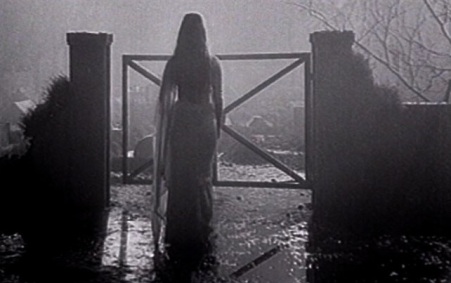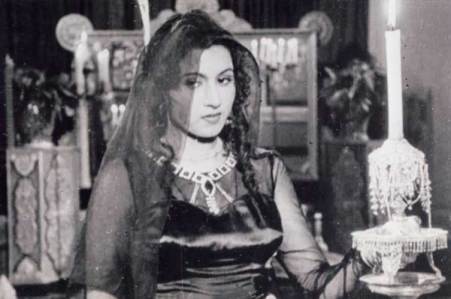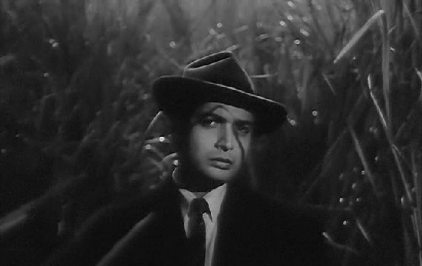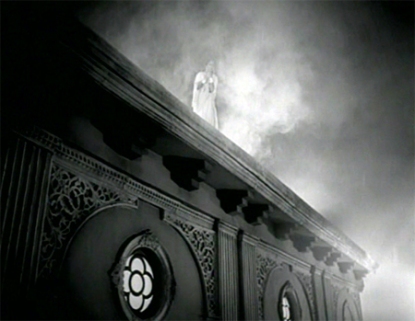Sadhana enters a graveyard as the femme fatale of Woh Kaun Thi? (1964)
In the U.S. historians and film theorists have debated for decades about the meaning of the elusive term: “film noir.” Although many of us conjure an image of a hard-boiled detective and a mystery made more mysterious by the femme fatale, few “film noirs” actually contain these elements. This so-called genre had its roots in German Expressionism with films like Fritz Lang’s M (1931) and in depression-era crime novels. But what does the term “film noir” mean as it applies to Hindi cinema? What are the hallmarks of this genre as it played out in Bollywood and how did it begin?
I will present five films that I propose to be in the genre of Indian film noir. This is no easy task. Just as the term is vague in the American lexicon, so too does it only hazily engulf a variety of Hindi films with low-key lighting. And so I shall begin with an illustrative example. We can debate the precise definition of the genre until the end of time, but I think I can safely say that whatever Indian film noir is, Woh Kaun Thi? (1964) is Indian film noir.
Woh Kaun Thi? has 4 main basic elements. The first is in its distinct cinematographic style and setting—low-key lighting throughout a mysterious mansion and slow unhurried shots with a somber film score to match. The film gives a sense of the world being trapped in a fatalistic dream, whether alone by a graveyard or in a crowd of dancing people.
The second is the film’s overall tone and pacing—there is an uncomfortable sense of being pursued, of an impending doom unless a mystery is solved in time by the hero. Unlike in American film noir, the hero is no cynic and there is no quick sardonic dialogue to off-set the dreary mood. The hero is instead a righteous and innocent man of affairs, an heir to a fortune who becomes a victim. Though mingled with occasional musical highs, the film spirals from a slow and deliberate set-up to a climax closer and closer to complete ruin.
An interesting element of many American film noirs is the flash-back structure, which takes on an interesting form in their Indian counterparts. Woh Kaun Thi?centers around a mysterious background that occurred in the protagonist’s past life. Because the audience of Hindi films was largely composed of practicing Hindus, the world of reincarnation narrative is able to begin on a new and creatively extremely fertile ground. The hero must revisit through song, hearsay, and secrets events that took place in a past life, but whose consequences (whether karma or otherwise) now haunt him. This is the third element.
Fourthly, the film does indeed revolve around the appearance and (mis)guidance of the femme fatale, who is heard singing alluring, tragic songs. The hero is never able to wholly communicate with her, but her intentions are clearly marked with a deadly undertone. The femme fatale remains an elusive character–sometimes he chases after her, sometimes she chases after him—when her story is fully told, only then can the mystery be solved.
The films below can be placed into the category of Indian film noir along withWho Kaun Thi?:
Mahal (1949): Perhaps the grandfather of this genre, Mahal tells of a man tortured and madly in love with an apparition who haunts his mansion and claims a connection from an earlier life. The film also features the haunting vocals of Lata Mangeshkar’s all-time hit Aayegaa Aanewaalaa.
Madhubala mesmerizes Ashok Kumar in Mahal (1949)
Madhumati (1958): This classic Vijayantimala-Dilip Kumar blockbuster is told in flashback to a previous lifetime of the murder of the woman the hero still loves. The gently alluring Aajaa Re Pardesi encompasses the film’s themes of love and debts spanning several lifetimes.
Vijayantimala is reincarnated to find her lover once more in Madhumati (1958)
Bees Saal Baad (1961): A rich man comes to live in his new mansion and must solve a tragedy and murder that occurred 20 years earlier. The film contains a brilliant surprise ending, and Lata Mangeshkar scores once again with the beautiful Kahin Deep Jale, Kahin Dil.
Biswajeet follows a mysterious voice in Bees Saal Baad (1961)
Kohra (1964): This twist on Hitchcock’s Rebecca is told through the eyes of a female protagonist, living in a large, unexplored mansion that is haunted by the apparition of her husband’s first wife. Waheeda Rehman must discover the true circumstances surrounding the first wife’s death before she is driven insane. The song of the femme fatale (Jhoom Jhoom Dhalti Raat) is an absolutely genius and rare example of symbolic imagery in montage to create a feeling of horror from the song.
Waheeda Rehman sees a ghostly vision atop her mansion roof in Kohra (1964)
There are some films that contain one or more of the above elements that I havenot classified as Indian film noir. These include Mera Saaya, Gumnaam, andKarz, for different reasons–often overall tone or cinematographic style. Additionally, others might argue that these films should not be categorized at all as Indian film noir, but rather as Indian gothic horror films or other such genres. Watch some of these classics and let me know your take on this chapter in cinematic history!





No comments:
Post a Comment